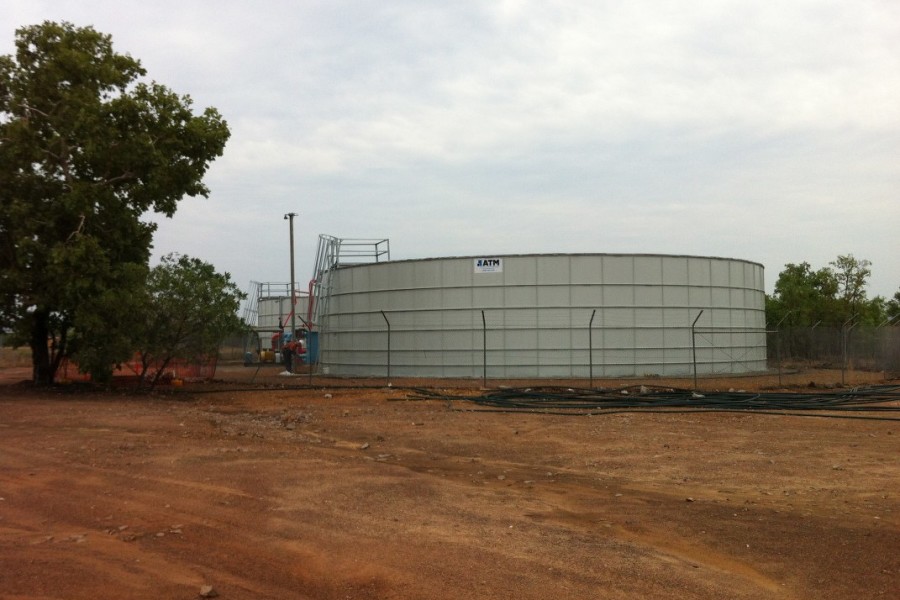Advantages and Disadvantages of Panel Tanks
Steel panel tanks also known as modular tanks have a number of advantages over their potential substitute counterparts as well as a couple of disadvantages all of which will be discussed in brief on this page. The goal of this article is to provide quality, concise, information for the intent of helping consultants, engineers and project managers with making the best decisions regarding specifications and purchasing suited for the requirements of the application.
Storage Capacity
The first and most important question to answer is how much water storage is needed? Round tanks are the most cost effective method of storing most non-hazardous liquids from 80,000Ltrs up to 10,000,000 Litres. For tanks smaller then 80KL it is usually allot cheaper and quicker to install a couple of small poly tanks with a similar design life as lower spec panel tanks (low spec will be discussed in the next paragraph). There are very few tanks, panel or modular, bigger than 10 Mega litres (10 million litres), not because they can’t be built much bigger, rather, it becomes a question of design life. Many larger tanks are for council drinking water reservoirs or oil storage tanks which are specified to last from 50 to 100 years.
The Price
The real value in panel tanks is seen when comparing the cost of them to concrete and welded steel tanks, you can expect to spend from 100% to 500% more on a concrete or welded steel tank then on a panel tank. A good example of the price difference is when an oil processing plant in Western Australia wanted a 250,000 Litre fire tank they originally proffered welded steel due to its design life, however when the budget came back at just shy of $1,000,000.00 they quickly looked for alternatives, along came a high spec panel tank with all the bells and whistles for $220,000.
Design Life
At this point you need to answer the second most important question. What are the design life requirements of this tank? Most tanks over 10 Mega litres are concrete or welded steel for one reason, they need to achieve a design life of 50 to 100 years. Panel tanks are extremely versatile, by choosing different ‘modifications’ and options you can select a tank which will last from 25 years all the way up to 50 years. Obviously, the price of the tank increases depending on its specifications. Like a car, and unlike all other tanks a panel tank has the benefit of being like a Meccano set, meaning you have options to easily bolt on, add, remove, and modify all components in them including stairs, ladders, fittings, roofs, manholes and even change the waterproofing, what this means is, you could buy a cost effective panel tank with a design life of 25 years, then at 20 years you could upgrade it to a 50 year design life by modifying the roof and waterproofing. An very useful feature for mines, councils and large construction firms is the fact that a panel tank company can pull down a 10 mega litre tank within a week, then rebuild it on the other side of Australia the following week often within a couple of weeks notice.
Panel Tank Options
So what are the options you can have on a tank which affects its design life? In short everything in a panel tanks is variable. Wall sheet thickness’s range from 0.48mm thick for some rural farm tanks all the way up to 20mm thick for mega litre reservoir storage, coatings include colour bond for farm tanks to galvanised steel for fire tanks to glass resin and epoxy coatings. Similarly panel tanks can be built without roofs, however if you want a roof you have the option of purchasing a cheaper durian purling roof structure with zinc-alum sheeting and a centre column support, or a self supported hot dipped galvanised roof structure with colour-bond ultra sheeting and a roof liner or you could even go with a new membrane liner roof to avoid corrosion all together.
Water proofing
Waterproofing selection is critical as it is the main contributing factor to a panel tanks design life, a poor liner selection can cause significant costs in the short run as well as the long. As a rough guide, if you want to store council water for fire protection, meaning the tank will almost always be full, then you may want to select a 0.75mm PVC liner for price competitiveness, however, if the tank will be filling and emptying regularly with a variety of chemicals then you’ll need a reinforced liner with a scrim (a thread inside the liner) which will not shrink and can handle the fluctuations. There is no shortage of liner or waterproofing options, you can go with a gasket tank, mastic sealed, flexible bladder like PVC or PTR or you could use a rigid liner like HDPE. Spray on liquid rubber and polyurethane coatings are becoming popular, however these coatings are a lot more expensive and require significantly more attention to detail in preparation, unfortunately this means that many companies doing these coatings get it wrong, due to insufficient preparation causing large repair costs. Most panel tanks can be manufactured and installed within 8 weeks from order compared to the 6 months for concrete and welded tanks.
The Conclusion
Like most products panel tanks has it’s time and it’s place, it is not for all applications and anyone selling a panel tank offering a 100 year design life is choking your chain, but when you need more than 80,000 litres stored, the budget is tight and a 25-50 year design life is acceptable there is really no competition for the versatility and customisable nature of panel tanks.

